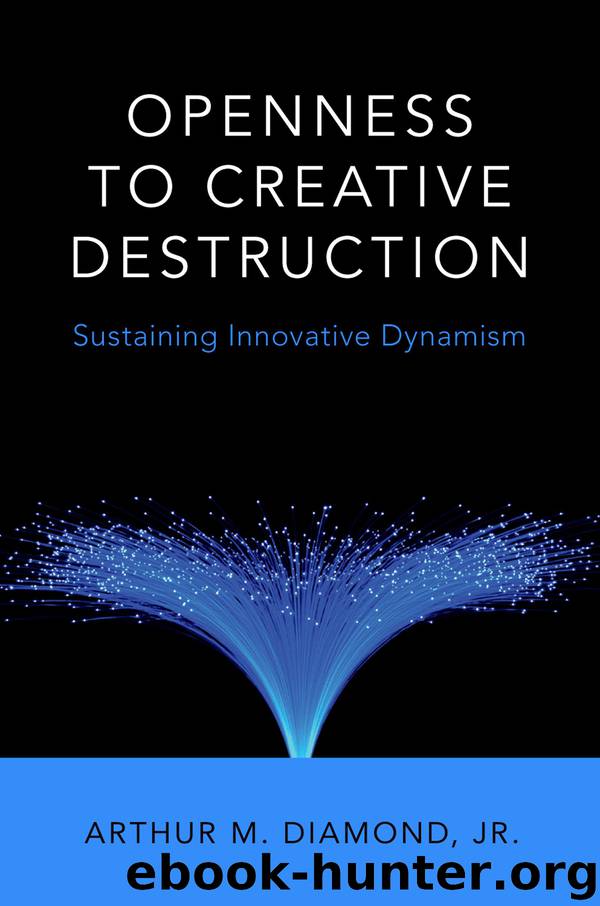Openness to Creative Destruction by Arthur M. Diamond Jr

Author:Arthur M. Diamond, Jr.
Language: eng
Format: epub
Publisher: Oxford University Press
Published: 2019-03-06T16:00:00+00:00
Economic Case Against Patents: Monopoly Pricing, Legal Costs, and Barriers to the Interaction of Ideas
Traditionally, the standard theoretical argument against patents has been that they create monopolies and that monopolies result in lower output and increased prices for consumers.31 The implication of lower output has not always been supported empirically. For example, economists Darius Lakdawalla and Tomas Philipson presented evidence that patent-induced monopoly does not much reduce the output of prescription medicines.32 They attribute this to firms having a greater incentive to invest in marketing when they have a monopoly due to patents.
But most of the focus in the standard argument has been on consumers being harmed by higher prices from patent-created monopolies. As I foreshadowed in chapter 5 and chapter 8, two common aspects of the initial high prices from patent monopolies may mitigate their burden. One is that they are often borne by rich consumers. The other is that they often provide funding for the improvement of early versions of the new good. At the start and in the short run, some new goods (cars, VCRs) are only affordable by the rich. But the early versions are often fragile, buggy, and hard to use. Thus, rich consumers often provide the critical mass of venturesome consumers who are essential for the survival and improvement of the new goods.33
When the new goods have become much better and much less costly to make, even those innovators with active patents may find it more profitable to follow Henry Ford in selling at low prices to the masses rather than selling at high prices to the rich. A similar result can occur with process inventions; the patented monopoly new process can result in lower prices than the static-textbook-competitive-old-process. McCloskey provides a graphical illustration, showing that the monopoly price of railroad hauling may be lower to the consumer than the textbook-competitive price of pack-mule hauling.34
A more recent part of the economic case against patents emphasizes the high, and increasing, costs of patent lawsuits.35 The direct costs of lawsuits are substantial, but another cost of lawsuits is in the large loss of stock value, often suffered mainly by accused patent infringers. These costs may be justified if they are borne to defend the property of breakthrough inventors, but the costs seem outrageous when they are caused by lawsuits based on low quality patents.
One way in which patents can be of low quality is for them to be written and approved in a highly ambiguous form, which results in other firms not knowing when they might be violating a patent.36 Another way in which patents can be of low quality is for them to be granted in spite of the failure of the invention to be truly new and nonobvious. Jeff Bezos opposes low quality patents of this kind, even though Amazon has benefitted from holding one—the patent for the “one-click” purchase button on online sites.37
The rising costs of litigation are sometimes blamed on “patent trolls.”38 The moniker has negative connotations, but its exact meaning is not clear.
Download
This site does not store any files on its server. We only index and link to content provided by other sites. Please contact the content providers to delete copyright contents if any and email us, we'll remove relevant links or contents immediately.
| Consulting | Entrepreneurship |
| Franchises | Home Based |
| Marketing | New Business Enterprises |
| Nonprofit Organizations & Charities |
Pioneering Portfolio Management by David F. Swensen(6164)
Man-made Catastrophes and Risk Information Concealment by Dmitry Chernov & Didier Sornette(5870)
Zero to One by Peter Thiel(5629)
The Motivation Myth by Jeff Haden(5116)
The Miracle Morning by Hal Elrod(4490)
Elon Musk by Ashlee Vance(3976)
The Art of Persistence: Stop Quitting, Ignore Shiny Objects and Climb Your Way to Success by Michal Stawicki(3595)
Unlabel: Selling You Without Selling Out by Marc Ecko(3550)
Delivering Happiness by Tony Hsieh(3326)
Urban Outlaw by Magnus Walker(3298)
Purple Cow by Seth Godin(3102)
Mastering Bitcoin: Programming the Open Blockchain by Andreas M. Antonopoulos(2944)
The Marketing Plan Handbook: Develop Big-Picture Marketing Plans for Pennies on the Dollar by Robert W. Bly(2896)
The Content Trap by Bharat Anand(2833)
The Power of Broke by Daymond John(2824)
Applied Empathy by Michael Ventura(2805)
The Airbnb Story by Leigh Gallagher(2747)
Keep Going by Austin Kleon(2661)
Radical Candor by Kim Scott(2604)
